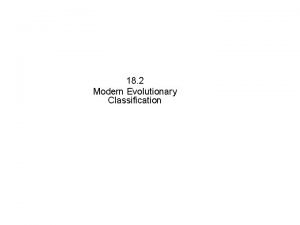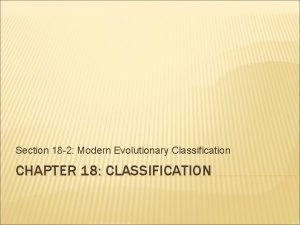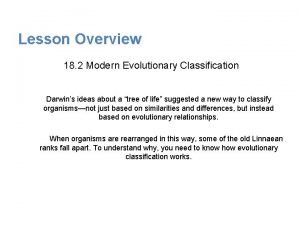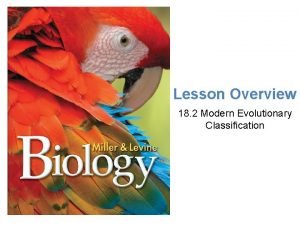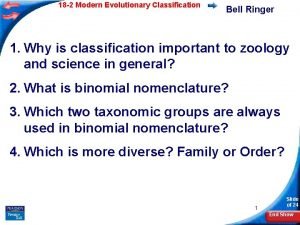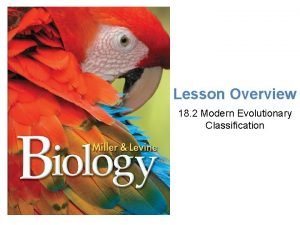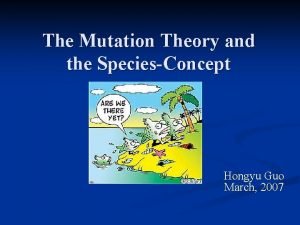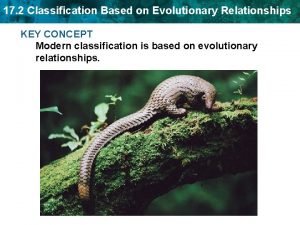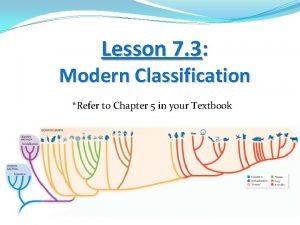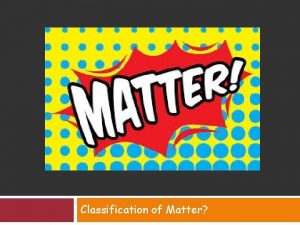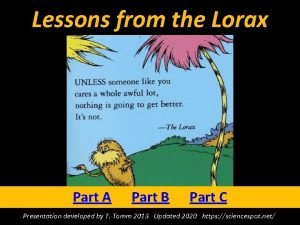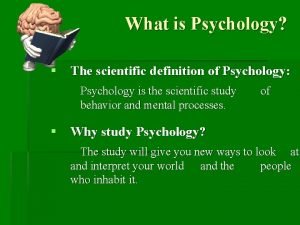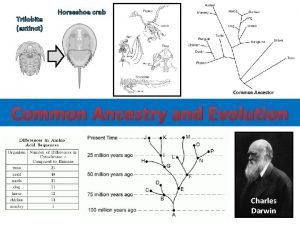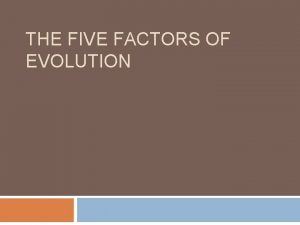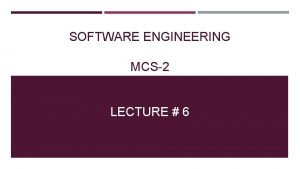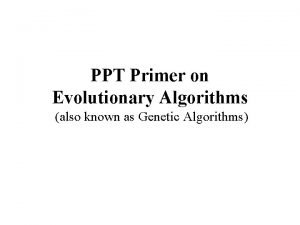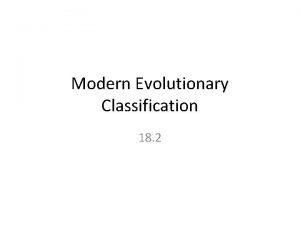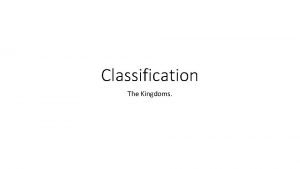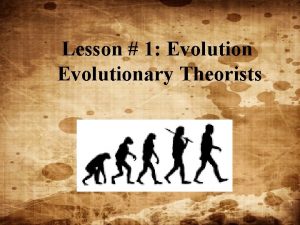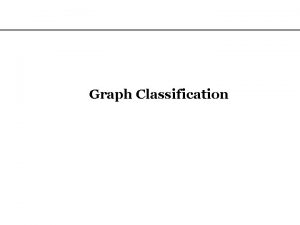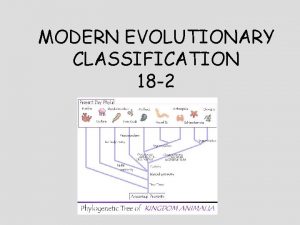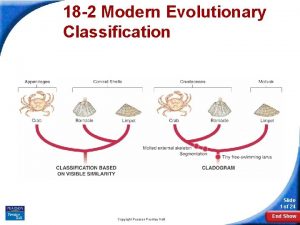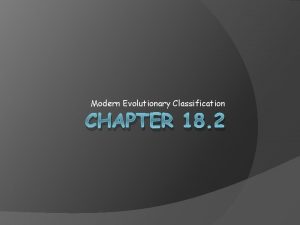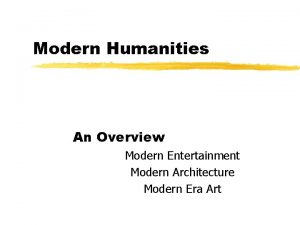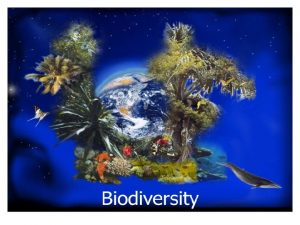Lesson Overview 18 2 Modern Evolutionary Classification THINK

























- Slides: 25

Lesson Overview 18. 2 Modern Evolutionary Classification

THINK ABOUT IT Darwin’s ideas about a “tree of life” suggested a new way to classify organisms—not just based on similarities and differences, but instead based on evolutionary relationships. When organisms are rearranged in this way, some of the old Linnaean ranks fall apart. To understand why, you need to know how evolutionary classification works.

Evolutionary Classification What is the goal of evolutionary classification? The goal of phylogenetic systematics, or evolutionary classification, is to group species into larger categories that reflect lines of evolutionary descent, rather than overall similarities and differences.

Evolutionary Classification The concept of descent with modification led to phylogeny—the study of how living and extinct organisms are related to one another. Advances in phylogeny, in turn, led to phylogenetic systematics, or evolutionary classification. Phylogenetic systematics groups species into larger categories that reflect lines of evolutionary descent, rather than overall similarities and differences.

Common Ancestors Phylogenetic systematics places organisms into higher taxa whose members are more closely related to one another than they are to members of any other group. The larger a taxon is, the farther back in time all of its members shared a common ancestor.

Clades A clade is a group of species that includes a single common ancestor and all descendants of that ancestor—living and extinct. A clade must be a monophyletic group. A monophyletic group must include all species that are descended from a common ancestor, and cannot include any species that are not descended from that common ancestor.

Cladograms What is a cladogram? A cladogram links groups of organisms by showing how evolutionary lines, or lineages, branched off from common ancestors.

Cladograms Modern evolutionary classification uses a method called cladistic analysis to determine how clades are related to one another. This information is used to link clades together into a cladogram, which illustrates how groups of organisms are related to one another by showing how evolutionary lines, or lineages, branched off from common ancestors.

Building Cladograms A speciation event, in which an ancestral lineage branches into two new lineages, is the basis for each branch point, or node. Each node represents the last point at which the new lineages shared a common ancestor. The bottom, or “root, ” of the tree represents the common ancestor shared by all organisms on the cladogram.

Building Cladograms A cladogram’s branching patterns indicate degrees of relatedness among organisms. Because lineages 3 and 4 share a common ancestor more recently with each other than they do with lineage 2, you know that lineages 3 and 4 are more closely related to each other than they are with lineage 2.

Building Cladograms Likewise, lineages 2, 3, and 4 are more closely related, in terms on ancestry, with each other than any of them is to lineage 1.

Building Cladograms This cladogram represents current hypotheses about evolutionary relationships among vertebrates. Note that in terms of ancestry, amphibians are more closely related to mammals than they are to ray-finned fish!

Derived Characters In contrast to Linnaean classification, cladistic analysis focuses on certain kinds of characters, called derived characters, when assigning organisms into clades. A derived character is a trait that arose in the most recent common ancestor of a particular lineage and was passed along to its descendants.

Derived Characters Whether or not a character is derived depends on the level at which you’re grouping organisms. Four limbs, for example, is a derived character for the clade tetrapoda. Hair is a derived character for the clade Mammalia, but four limbs is not derived for mammals. If it were, only mammals would have four limbs!

Derived Characters Specialized shearing teeth is a derived character for the clade Carnivora—of which both the coyote and lion are members. Neither hair nor four limbs is a derived character for this clade. Retractable claws is a derived character for the clade Felidae (the cats). Notice that lions have this trait, but coyotes do not.

Losing Traits Because distantly related groups of organisms can lose the same character, systematists are cautious about using the absence of a trait as a derived character. For example, both whales and snakes have lost the tetrapod character of four limbs—but they are not very closely related. Snakes are members of the clade Reptilia, while whales are members of the clade Mammalia.

Clades and Traditional Taxonomic Groups A clade must be monophyletic. This means that it contains an ancestral species and all of its descendants, and no species that are not descendants of that ancestor. Cladistic analysis shows that many traditional taxonomic groups do form valid clades. Linnaean class Mammalia, for example, corresponds to clade Mammalia.

Clades and Traditional Taxonomic Groups In other cases, however, traditional groups do not form valid clades. Today’s reptiles are all descended from a common ancestor. Modern birds, however, are also descended from that ancestor. Linnaean class Reptilia, which does not include birds, is therefore not a valid clade.

Clades and Traditional Taxonomic Groups

Clades and Traditional Taxonomic Groups Two clades do include the birds: clade Aves, (the birds themselves), and clade Reptilia. Therefore, according to cladistics, a bird is a reptile!

DNA in Classification How are DNA sequences used in classification? In general, the more derived genetic characters two species share, the more recently they shared a common ancestor and the more closely they are related in evolutionary terms.

Genes as Derived Characters All organisms carry genetic information in their DNA passed on from earlier generations. A wide range of organisms share a number of genes and show important homologies that can be used to determine evolutionary relationships.

Genes as Derived Characters Because all genes mutate over time, shared genes contain differences that can be treated as derived characters in cladistic analysis. For that reason, similarities and differences in DNA can be used to develop hypotheses about evolutionary relationships. This suggests that American vultures are more closely related to storks than to other vultures.

New Techniques Suggest New Trees The use of DNA characters in cladistic analysis has helped to make evolutionary trees more accurate. For example, traditionally African vultures and American vultures were classified together in the falcon family. Molecular analysis, however, showed that DNA from American vultures is more similar to the DNA of storks than it is to the DNA of African vultures.

New Techniques Suggest New Trees Often, scientists use DNA evidence when anatomical traits alone can’t provide clear answers. DNA analysis revealed that the giant panda shares a more recent common ancestor with bears than with raccoons. Therefore, the giant panda has been placed in a clade with bears. Red pandas, however, are in a clade with raccoons and other animals like weasels and seals.
 Lesson 14 modern evolutionary classification
Lesson 14 modern evolutionary classification Section 18-2 modern evolutionary classification
Section 18-2 modern evolutionary classification What is the goal of evolutionary classification
What is the goal of evolutionary classification Section 18-2 modern evolutionary classification
Section 18-2 modern evolutionary classification Red panda life cycle
Red panda life cycle Section 18-2 modern evolutionary classification
Section 18-2 modern evolutionary classification Modern evolutionary classification
Modern evolutionary classification Think big think fast
Think big think fast Modern evolutionary synthesis
Modern evolutionary synthesis Classification based on evolutionary relationships
Classification based on evolutionary relationships Classification based on evolutionary relationships
Classification based on evolutionary relationships Traditional classification vs modern classification
Traditional classification vs modern classification Think said the robin
Think said the robin Think fam think
Think fam think Copper wire classification of matter
Copper wire classification of matter Chapter 9 lesson 2 photosynthesis an overview
Chapter 9 lesson 2 photosynthesis an overview Lesson overview
Lesson overview How is thneedville different from today's world
How is thneedville different from today's world Scientific psychology definition
Scientific psychology definition Vuzzer: application-aware evolutionary fuzzing
Vuzzer: application-aware evolutionary fuzzing Ancestry
Ancestry Genetic drift definition biology
Genetic drift definition biology Evolutionary maintenance
Evolutionary maintenance Evolutionary software process models
Evolutionary software process models Evolution of logistics ppt
Evolution of logistics ppt Kingdom plantae phylogenetic tree
Kingdom plantae phylogenetic tree
